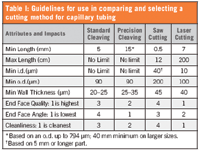Advances in Cutting and Cleaving of Fused Silica Capillary Tubing
Polymicro Technologies, a subsidiary of Molex Inc.
Polyimide coated fused silica capillary tubing is frequently employed in a variety of analytical instrumentation. In this application note we revisit methods for cutting and cleaving capillary tubing with a focus on recent advances.
Fused silica capillary tubing's unique properties have made it a key component in separation scientist's tool box. Although used in analytical techniques such as GC, CE, capillary LC, CEC, and cytometry, it is of increasing importance in the area of fluid metering such as in drug delivery systems. Its dimensional precision is unmatched for microfluidic interfacing and mass flow control. The easy of cutting capillary to length is a key attribute, but care must be taken to insure that the appropriate cutting or cleaving method is selected so that optimum system performance is achieved.
Previous publications have outlined and defined the four primary methods of end face preparation, with those being standard cleaving, precision cleaving, laser cutting, and saw cutting (1,2). Subsequent work provided more detailed guidance on selecting the most optimum method (3). In this latter effort tubing attributes such as i.d., o.d. and wall thickness were considered, as were there influence on finished part length. A comparative analysis of end-face quality, perpendicularity, and cleanliness of the different techniques was also made. Advances in cutting and cleaving methods have been realized and are discussed in this note.
Recent Advances
Standard Cleaving — Cleaving capillary tubing to lengths less than 20 mm while maintaining a good end face had been challenging at the production level. Improvements in technique now allow standard cleaving to lengths as short as 5 mm on nearly all tubing products.
Precision Cleaving — This increasingly popular technique has seen similar reductions in finished part length due to tooling advances. Lengths as short as 15 mm are now achievable. This applies to tubing with a high glass cross sectional area such as our new 1/32" OD Capillary. Polymicro has also developed the ability to provide precision cleaved parts with up to 35 mm of the polyimide removed from the cleaved end. Previously, parts with this length of polyimide removed would have required a laser cut or lower quality standard cleave.
Saw Cutting — The maximum part length for saw cutting has increased from 4.5 cm to 12 cm due to investments in state of the art sawing equipment. New cleaning techniques allow for processing of tubing with i.d. down to 40 µm. As in the past, part length is limited when saw cutting small i.d. tubing. Likewise, the minimum o.d. that can be processed has been lowered. For short parts, the o.d. can be as low as 200 µm.
Laser Cutting — Industry leading attributes previously listed for laser cutting remain unchanged. However, related advances realized include improved control of end face contour of thick wall parts. Further, developments in the associated laser based polyimide removal techniques and equipment now allow for ablation of longer lengths of polyimide, i.e. up to 40 mm on most tubing products.
Table I summarizes the current guidelines for use in selecting the most appropriate cutting and cleaving method for your application.

Table I: Guidelines for use in comparing and selecting a cutting method for capillary tubing
Conclusion
This note reviewed recent advances in the primary techniques employed for cutting and cleaving capillary tubing. For assistance with your specific application please contact a Polymicro Technical Sales Specialist.
References
(1) "Cutting and Cleaving Capabilities", The Book on the Technologies of Polymicro, Polymicro Technologies Publication (2011), pp. 3–5.
(2) J. Macomber, R. Hintz, T. Ewing, and R. Acuna, LCGC Application Notebook, June 2005, p. 81.
(3) J. Macomber, P. Lui, and R. Acuna, LCGC Application Notebook, Sept. 2009, p. 66.
Polymicro Technologies, a subsidiary of Molex Inc.
18019 N. 25th Ave., Phoenix, AZ 85023
tel. (602) 375-4100
Website: www.polymicro.com

The Benefits of Custom Bonded Silica
April 1st 2025Not all chromatography resins are created equal. Off-the-shelf chromatography resins might not always meet the rigorous purification requirements of biopharmaceutical manufacturing. Custom bonded silica from Grace can address a wide range of separation challenges, leading to real performance improvements. Discover more about the latest innovations in chromatography silica from Grace, including VYDAC® and DAVISIL®.
5 Things to Consider When Selecting a Chromatography Silica
April 1st 2025Particularly in the pharmaceutical industry, drug purity isn’t just a goal – it’s essential for achieving safety, stability and efficacy. However, purification is easier said than done, especially with challenging molecules like DNA and RNA “oligonucleotides,” due in large part to their diversity and the range of impurities that can be generated during production. Enter DAVISIL® chromatographic silica, with a wide range of pore diameters and particle sizes to meet your specific application, performance and sustainability requirements. Before you choose the chromatography resin for your next purification application, take a look at these 5 considerations.
Automating Protein Purification: Efficiency, Yield, and Reproducibility
March 27th 2025Recent advancements in automated protein purification stress the importance of efficiency, scalability, and yield consistency. This eBook compares different purification platforms, highlighting their impact on downstream applications and demonstrating how automation enhances throughput and process control.
MilliporeSigma: Ultrapure Water for Sensitive LC-MS Analysis of Pesticides
March 25th 2025The aim of the study was to illustrate the efficiency of Milli-Q® water purification systems in eliminating pesticides from tap water, thereby producing and delivering reliable and consistent-quality ultrapure water suitable for pesticides analysis















